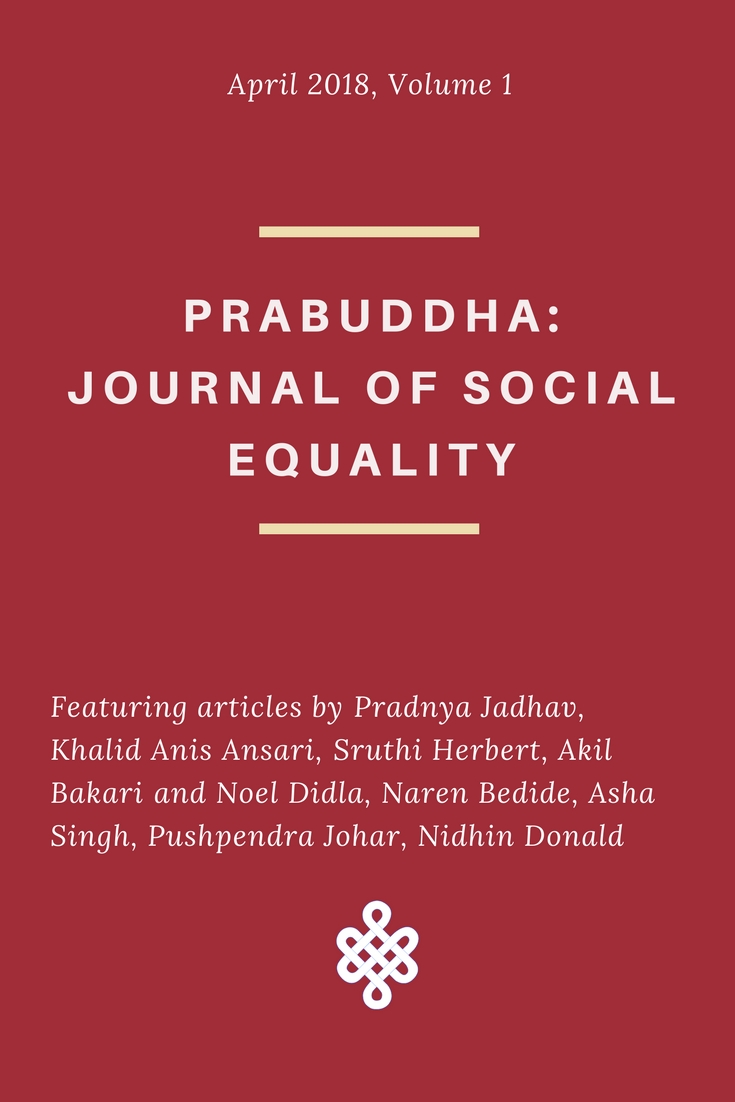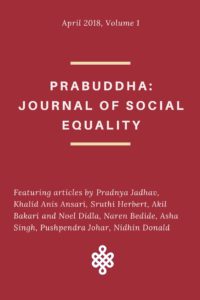Pradnya Jadhav
The first issue of Prabuddha: Journal of Social Equality carries research articles and an interview by Dalit Bahujan Women scholars. SAVARI is happy to share excerpts of their articles here.
This excerpt is from Pradnya Jadhav’s article on the Namantar Movement under the journal section of Research Papers. Please read Prabuddha’s About page and Instructions for Authors if you would like to submit articles.
An excerpt from “Namantar Struggle: A Non-religious Political Movement of Ambedkarites in Maharashtra”
The role of Ambedkarite ideology
The overall Dalit movement in Maharashtra and the Namantar Andolan manifests Dr. Ambedkar as an ideologue, a scholar whose vision led to the emergence of Dalits as a conscientised mass. Ambedkarite ideology has prepared the masses to articulate the meaning of their existence, their political mobilisation, and consciousness building. The ideology of Dr. Ambedkar has proved its utility in all the spheres of the Dalit liberation movement.
The Namantar Andolan emerged as the ground for the emergence of Dalit movement in the region; it highlighted the presence of Dalit groups operating in Marathwada. Dalit Youth Front (Dalit Yuva Aghadi) was distinct: they were active in the rural Marathwada taking up the issues of distribution of Gayran to the Dalits, addressing the issues related to the practice of untouchability. The first ever Satyagraha for access to water was initiated by the activists of Dalit Youth Front in Khalwat-Nimgaon, in Majalgaon Block of Beed district. After the Satyagraha, they were boycotted in the village by the savarnas, however, the Dalits stood firm. Namantar was not the main demand of Dalit Youth Front, it was one of their concerns. The activists of this front did remarkable work in the post-violence situation in 1978, by visiting the violence affected villages, conducting fact-finding reports and helping the victims to shift to safe places.
In the post-violence following the riots in the second phase of Namantar, the state government announced certain decisions to appease the violence affected Dalits. This included establishing Mahatma Phule Backward Class Finances and Development Corporation. The idea behind setting up this corporation was to provide financial support to Dalits for self-employment initiatives. However, this initiative gave a fatal blow to the assertive nature of the movement. It was a tactical move of the Government to silence the anger of the Dalits by giving monetary benefits and not implementing the name change.
Concluding remarks
This study provides multiple vantage points to understand the Namantar Andolan through the author’s familiarity with the Marathwada region, Marathi language, access to Namantar activist networks, materials and institutions engaged in memorializing the movement. The extensive examination of material produced in the Marathi language during and since the period of Namantar movement opens several interesting frameworks to study similar emancipatory movements.
The process of naming entities is one of the oldest human activities. Names of people, places, and things orient us to our realities, provide contexts and direction. In the book ‘The means of names: a social history,’ Stephen Wilson (1998) posits: “Names of all kinds have associations, flavours; they are evocative, and carry messages and they are powerful.”
A clear hegemonic way of life is to ensure that naming rights are withheld from the marginalized, particularly the naming of entities in the public sphere. Namantar Andolan is a struggle that played out for 20 long years to claim the Dalits’ right to name a university in Marathwada region after Dr. Ambedkar.
Namantar as an agitation has been discussed at length by the Dalits writing on Namantar and the savarnas documenting Namantar. It is important to understand the political and ideological affiliations of those who wrote on Namantar, as their writings and approach appeared in accordance with their ideological base. Dalit Panther alone had a separate rally for Namantar, so did a few other Dalit groups such as Dalit Yuvak Aghadi (Dalit Youth Front). There were other groups of Humanists, Socialists, Left progressives, and liberals such as Yuvak Kranti Dal, CPI, CPM and CPI (ML). Each group expressed their version of the story and claimed their participation. In the process of unravelling the realities of Namantar, it is important to understand the extent to which these groups contributed and their position in the Post Namantar era for the Dalits. Available literature gives us a picture of the state impunity in the cases of atrocities against Dalits as no laws were strictly implemented and no justice was ensured.
In the aftermath of the violence, there was a proposition of setting up a technical university in the Konkan region. The supporters of Namantar wanted to represent the interests of the whole population of Marathwada, but that never happened. Instead, another sub-centre of the Marathwada University was set up in Osmanabad district. In Nanded, a separate university was formed for four districts: Nanded, Parbhani, Hingoli, and Latur. This university was named after the opponent leader of Namantar, Swami Ramanand Tirth. It is hence necessary to answer the question if the struggle for Namantar was a victory or a failure? And there is a need to understand its impact on the Dalits in Marathwada region.
The omission of some historical events by those who documented Namantar requires closer inspection, for it appears that the sacrifice by Gautam Waghmare and Vilas Dhone and others have been hardly documented by the few savarna writers. Raising the fundamental question – who does this exclusion, and why? As a researcher and a part of the community, I realised that we need to ask these questions while we celebrate their sacrifices. We also need to think for a while about their family members. And think about to whom should this complaint about the erasure of their sacrifice be addressed?
The riots and sacrifices of Dalit activists are black spots in the history of Namantar struggle. The first concern was to address the rehabilitation issues of those dispossessed during the violence. The number far exceeded the official figures. Secondly, a failure of the justice delivery system which let the attackers go free needed to be addressed. The registration of crimes against Dalits was almost negligible, as if they were only a natural part of the lives of Dalits.
In the global context, several movements have engaged with the decolonizing of history and creating a better present, often by renaming and replacing the symbols of racism. It is evident in the case of Argentina where the statue of Christopher Columbus was replaced with the monument of the Bolivian War of Independence heroine Juana Azurdy. Namantar Andolan in the global narrative is one of the many renaming movements for the rightful claiming of the public sphere, by correcting distorted historical narratives and memorializing progressive actors from marginalized communities. It was a movement to claim the educational institution as the public space, and thereby renaming the Marathwada University with arguments that were not sentimental but factual. This was the historic assertion against the fundamental feature of the caste society: excluding the marginalised communities from the public sphere. Although it is difficult to conclude about the struggle for Namantar in terms of victory or failure, it did provoke a critical engagement on an ideological basis for anti-caste movements. Several unasked questions linger, such as can there be ethics to the way movements are remembered? If yes, then why is there hardly any mention of the family members of those who committed suicide for the demand of Namantar. The Namantar demand was supported by lakhs, but what happened to the families of the dead? Where have they disappeared?
Reference
Jadhav, P. (2018). Namantar Struggle: A Non-religious Political Movement of Ambedkarites in Maharashtra. Prabuddha: Journal Of Social Equality, 1(1), 13-32. Retrieved from http://prabuddha.us/index.php/pjse/article/view/14

